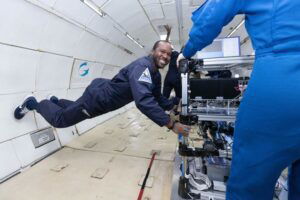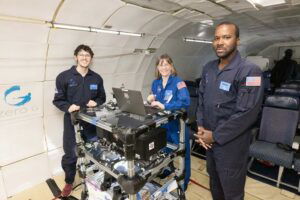Researchers from the Southwest Research Institute (SwRI) have analyzed the dynamics of boiling in partial gravity aboard a pair of parabolic flights designed to help future off-world prepare for some critical challenges associated with long-term habitation.
According to an announcement from SwRI, boiling will not only aid future lunar and Martian colonists in preparing food but will also be a critical tool used during these types of long-term space missions to “support surface power, life support systems, cryogenic fuel production and in situ resource utilization.”
“We have so little data about how boiling works in reduced gravity,” explained SwRI’s Kevin Supak, who is leading the project. “Our experiment studies boiling in conditions that simulate lunar and Martian gravity levels using four different surfaces to examine how bubbles initiate and detach.”


Designing Customized Surfaces to Test Boiling in Partial Gravity
Before taking flight, the team needed to design a series of customized surface treatments to study boiling on different surfaces. That’s because different surfaces result in different bubble sizes and different rates of bubble formation and detachment during the boiling process.
“When you’re boiling water on the stove, you’ll notice different bubble sizes and behavior between a stainless pot and a nonstick pot,” Supak explained. “This is because at the microscopic level, the surfaces look different, and their roughness affects how bubbles initially form and stick to the surface.”
For example, Supak says that previous experiments have shown that rougher surfaces often tend to form much smaller bubbles and also begin boiling faster. In contrast, smoother surfaces tend to form comparatively larger bubbles and begin boiling more slowly. Besides accelerating or decelerating how fast your space eggs boil, such differences can dramatically affect the operation and performance of a wide range of systems that will be used by future space colonists.
To aid the experiments, SwRI’s Materials Engineering Department was tasked with designing the different surface treatments that could be tested in a set of parabolic flights scheduled at the end of April. The team created four distinct surfaces, each with a different treatment and structure, to test a wide range of boiling in partial gravity scenarios.
“Bubble sizes, distribution, and surface temperatures will be studied on three variations of stainless-steel surface treatments and one highly structured plastic surface,” Supak explained.
Parabolic Flights Help Simulate Reduced Gravity
With their customized surfaces in hand, the team was ready to conduct their tests. Of course, performing these tests on Earth was not an option since they needed to study boiling dynamics in gravitational conditions similar to those found on Mars and the Moon. Fortunately, the team’s colleagues from Texas A&M University were able to help in the same way NASA trains its astronauts in simulated gravity environments: parabolic flights.
“It is difficult to simulate how boiling would work on the lunar and Martian surfaces in experiments conducted on Earth,” said Supak. “However, parabolic flight tests offer researchers brief periods of partial gravity to gain more insight into these complicated processes.”
Instead of jumping aboard NASA’s infamous “vomit comet,” SwRI research engineers Dr. Eugene Hoffman, Dr. Akbar Whizin, and Emilio Gordon climbed aboard a pair of flights taking off from Ft. Lauderdale, Florida, on April 24th. During the simulated partial gravity portions of these flights, the researchers submerged their various surface treatments into a specialized liquid that boils at a relatively tepid 135 degrees Fahrenheit.


Although the findings from these flight tests have not yet been made public, the researchers say they believe their results will help determine a number of key components about boiling in partial gravity that will help design customized materials and surfaces for the tools and equipment future colonists will use to boil water and other liquids in space.
“If we’re going to establish a sustained presence in space or on other worlds, boiling is a necessity,” Supak said. “On Earth, we rely on gravity to help separate liquids and gasses through buoyancy. On the lunar or Martian surface, the lower buoyancy force will result in different boiling behavior. We need to know how hot to make surfaces to ensure efficient and safe heat transfer. This flight test will produce data that are directly applicable to improving our understanding of these processes.”
Christopher Plain is a Science Fiction and Fantasy novelist and Head Science Writer at The Debrief. Follow and connect with him on X, learn about his books at plainfiction.com, or email him directly at christopher@thedebrief.org.

